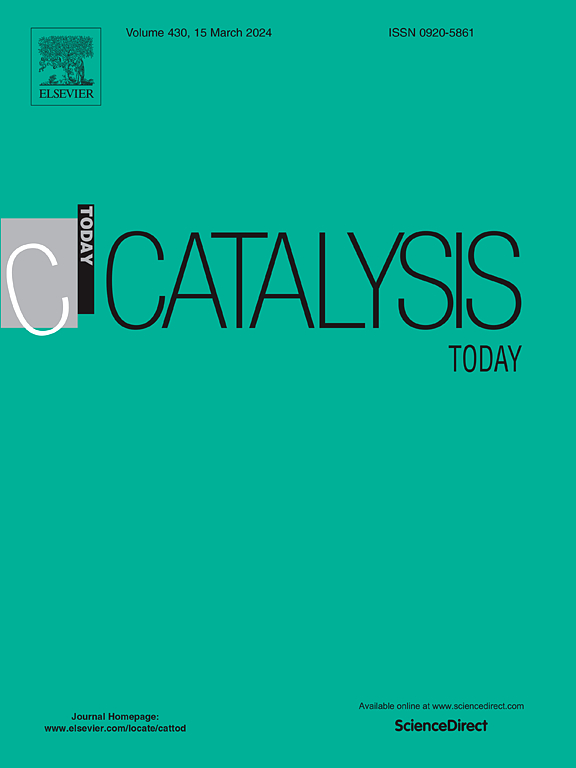Non-conventional hydrogen sources for the catalytic hydrogenation of biomass-derived levulinic acid to produce γ-valerolactone under mild conditions
IF 5.2
2区 化学
Q1 CHEMISTRY, APPLIED
引用次数: 0
Abstract
The use of biomass as a renewable energy source has been studied as an alternative to traditional and non-renewable energy sources in order to reduce the greenhouse gas emissions and decarbonize the economy. Levulinic acid (LA) is an important biomass-derived compound, that can be easily obtained by acid hydrolysis from biomass. LA can be transformed into high valuable chemical compounds by catalytic route, as for example in γ-valerolactone (GVL), which has important applications as additive or precursor of biofuels. The transformation of LA to GVL requires a hydrogen source and a proper catalyst. In this work, monometallic catalysts based on Ru and Ni as well as bimetallic RuNi supported on a zeolite have been synthesized and characterized by XRD, XPS and TEM. The hydrogenation of LA into GVL has been studied with these Ni/Ru catalysts using non-conventional hydrogen sources and the results have been compared with the traditional hydrogen source (pressurized molecular hydrogen). The alternative hydrogen sources used are: i) a system based on metallic Zn and water, where Zn can decompose water into hydrogen but it is oxidized to ZnO, ii) a combined system that uses hydrogen produced by photoelectrochemical (PEC) water splitting (WS) using a nanostructure of TiO2. The bimetallic catalyst led to the highest yield to GVL when Zn was used in the reaction, but the yields achieved are not remarkable (less than 25 %). Conversely, the monometallic catalyst based on Ru was the one that exhibited the highest yield to GVL when pressurized and PEC hydrogen were used. In this case, yields to GVL exceeding 95 % were achieved at 30 °C although the reaction time required was lower when pressurized hydrogen was used. Interestingly, a new system for PEC WS has been proposed, improving the contact between hydrogen and levulinic acid. This new system decreases the induction time, and enhances the GVL formation, especially at low reaction times. Finally, these catalysts are stable after reaction regardless of the source of hydrogen employed.
非常规氢源在温和条件下催化乙酰丙酸加氢生产γ-戊内酯
利用生物质作为一种可再生能源已经被研究作为传统和不可再生能源的替代品,以减少温室气体排放和经济脱碳。乙酰丙酸(LA)是一种重要的生物质衍生化合物,可以很容易地通过酸水解从生物质中获得。LA可以通过催化途径转化为高价值的化合物,例如γ-戊内酯(GVL),它作为生物燃料的添加剂或前体具有重要的应用。将LA转化为GVL需要一个氢源和合适的催化剂。本文合成了基于Ru和Ni的单金属催化剂以及负载在沸石上的双金属RuNi催化剂,并用XRD、XPS和TEM对其进行了表征。用Ni/Ru催化剂在非常规氢源条件下对LA加氢制备GVL进行了研究,并与传统氢源(加压分子氢)进行了比较。所使用的备选氢源有:i)基于金属锌和水的系统,其中锌可以将水分解成氢,但它被氧化成ZnO; ii)使用纳米结构TiO2的光电化学(PEC)水分解(WS)产生的氢的组合系统。以双金属催化剂为催化剂时,GVL的产率最高,但产率不显著(小于25% %)。相反,当加压和使用PEC氢气时,基于Ru的单金属催化剂对GVL的收率最高。在这种情况下,尽管使用加压氢气所需的反应时间较低,但在30°C下,GVL的产率超过95% %。有趣的是,提出了一种新的PEC WS体系,改善了氢和乙酰丙酸之间的接触。这种新系统缩短了诱导时间,并增强了GVL的形成,特别是在低反应时间下。最后,无论氢气来源如何,这些催化剂在反应后都是稳定的。
本文章由计算机程序翻译,如有差异,请以英文原文为准。
求助全文
约1分钟内获得全文
求助全文
来源期刊

Catalysis Today
化学-工程:化工
CiteScore
11.50
自引率
3.80%
发文量
573
审稿时长
2.9 months
期刊介绍:
Catalysis Today focuses on the rapid publication of original invited papers devoted to currently important topics in catalysis and related subjects. The journal only publishes special issues (Proposing a Catalysis Today Special Issue), each of which is supervised by Guest Editors who recruit individual papers and oversee the peer review process. Catalysis Today offers researchers in the field of catalysis in-depth overviews of topical issues.
Both fundamental and applied aspects of catalysis are covered. Subjects such as catalysis of immobilized organometallic and biocatalytic systems are welcome. Subjects related to catalysis such as experimental techniques, adsorption, process technology, synthesis, in situ characterization, computational, theoretical modeling, imaging and others are included if there is a clear relationship to catalysis.
 求助内容:
求助内容: 应助结果提醒方式:
应助结果提醒方式:


